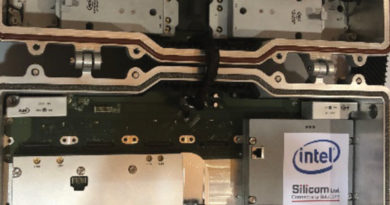Industry Alignment in Next Gen Efforts — This is Good Timing
By Nick Segura
The joint collaboration around the development of technical and operational standards to advance 10G Platform HFC technology and prepare for its adoption industry-wide has already spurred significant innovation from both the vendor and operator communities. Hybrid manufacturers are already testing inventive solutions to improve the performance of their products. Some of the modernizations receiving focus include mechanisms to reduce overall power consumption of chipsets, which can directly translate into system-wide power savings, as well as digital processing techniques, including pre-distortion and echo cancellation, for minimizing distortion artifacts and enabling the continued expansion of the RF bandwidth in our HFC networks.

Hardware innovations such as the Generic Access Platform (GAP), new distributed access architectures (DAA) and standardized MAC management platforms are opening the door to innovative deployment solutions that will not only expedite efficient adoption in growing service areas, they can also be deployed efficiently across some of our existing node platforms with minimal touch points. Furthermore, what is common to all of these emerging solutions will be their ability to support multiple architectures including DOCSIS mid-split, high-split, and ultra-high-split along with DAA, EPON FTTH and CBRS.
Ground-breaking machine learning and artificial intelligence technologies are looked at with great anticipation for making good use of the vast wealth of telemetry data available from the tremendous number of active devices residing in the plant and premises networks today. This has already driven the formation of working groups within CableLabs to examine the failure modes, effects, and criticality analysis (FMECA) of our cable access networks so operators can automatically identify the source of a failure and then determine what led up to the event so they can work on prevention tactics. Proactive network maintenance practices have taken many forms already, and industry adoption of DOCSIS tool enhancements is allowing field operations to find network issues before they become customer impacting.
 DOCSIS 4.0 comes with a promise of many more enhancements for PNM tools, especially in the upstream path where additional visibility is always welcomed. We anticipate the ability to someday leverage OFDM and OFDMA telemetry to enable dynamic allocation of modulation profiles depending on the conditions of the physical network, and there are many eyes watching for what smart features can be developed in newly manufactured FDD and FDX system amplifiers. Technicians could receive intelligent support from amplifier telemetry for setting up, aligning and remote reconfiguration. It may even be possible to realize dynamic carrier parameter changes when forward and return bandwidth splits get adjusted according to needed capacities from customer demand.
DOCSIS 4.0 comes with a promise of many more enhancements for PNM tools, especially in the upstream path where additional visibility is always welcomed. We anticipate the ability to someday leverage OFDM and OFDMA telemetry to enable dynamic allocation of modulation profiles depending on the conditions of the physical network, and there are many eyes watching for what smart features can be developed in newly manufactured FDD and FDX system amplifiers. Technicians could receive intelligent support from amplifier telemetry for setting up, aligning and remote reconfiguration. It may even be possible to realize dynamic carrier parameter changes when forward and return bandwidth splits get adjusted according to needed capacities from customer demand.
Standards supporting innovation:
All of these efforts could not have been possible without an extraordinary level of alignment across cable industry leaders, and through collaborative efforts with CableLabs and SCTE professionals participating in weekly forums to lay the framework and future roadmap for the industry at large.
The HFC path to 10G synergies was further fueled three years ago by the establishment of consortium calls with participation from more than 10 prominent cable telecommunications operators across the globe. Cable operators aligned to submit project authorization requests (PARs) through the SCTE standards program for the creation of 1.8/3.0 GHz taps, passives and actives standards. In parallel we worked determinedly to agree on minimum product requirement documents (PRDs) for RMD and RPDs, nodes and amplifiers, taps and passives, and DOCSIS CM CPE that served as a launch pad for these first of their kind plant hardware standards. Even with standardization many recognized that these efforts would spawn powerful intellectual property opportunities, and foster the submission of patents in many areas.

Operators’ alignment behind a common interest, and a clear message to accelerate technical developments, became the drivers behind the creativity and innovation pushing our industry forward today.
Industry standards-setting forums and impact:
Cable operators are vested with SCTE and CableLabs because of their expert abilities and strong relationships with other standards organizations and vendor manufacturers worldwide. Vendor suppliers are heavily vested as well, and dedicate staff to various engineering committees, interface practices and network operations subcommittees where industry recommended practices and operational practices are thoroughly vetted, adopted and reviewed periodically to ensure appropriate updates to reflect our changing operational environments.
The value of this relationship is further enhanced by the availability of extensive training development and certification programs including a content portfolio too large to accurately list in this short article. Committed SCTE and CableLabs professionals support operators large and small with future-looking technology standards and specifications, which help to greatly expedite adoption and operationalization of needed products and services.
- Some of the newest standards available for download can be found at https://www.scte.org/standards/library/catalog/ and include:
- Broadband Radio Frequency Hardline Taps for Cable Systems (ANSI/SCTE 264 2021)
- Broadband Radio Frequency Hardline Passives for Cable Systems (ANSI/SCTE 265 2021)
- 1.8 GHz Broadband Radio Frequency Hardline Amplifiers for Cable Systems (SCTE 279 2022)
- GAP Enclosure Specification — intended to standardize a mechanical clamshell housing and associated internal interfaces to enable a common platform for use in a wide variety of outside plant applications.
- GAP Modules Specification — detailing the requirements placed on interoperable modules for use in the GAP enclosure including physical, electrical, environmental constraints and module communications mechanisms.
- GAP Systems Integrator Best Practices — details the requirements placed on systems integrators tasked with performing functions such as design, installation, testing and deployment of a GAP system.
Well defined tools in the tool belt:
Operators now have many tools to select from that support a roadmap to deliver symmetrical gigabit services over DOCSIS, and leverage broad deployments of various HFC architectures. Depending on competitive market circumstances, operators can deploy the solution that works best for them, for the area, and at the appropriate time. A plant technology and CPE enablement roadmap can follow several paths and have various transition points. For example, a system operation with I-CMTSs may choose to deploy an HFC mid- or high-split architecture in a few markets with a transition plan to DAA, and then ES with ultra-high-split or FDX in follow-on markets. With DAA being a software-based platform there can be various spectrum bandwidth activation options performed only when needed. RF carrier quality will improve by moving SC-QAM and OFDM generation out to the node, which also reduces headend/hub needs, enables a path to D4.0, and provides a backend architecture that integrates with other fiber-based solutions such as 10G EPON. Furthermore, the ability to incrementally activate additional OFDM blocks can reduce node splits significantly. This in turn enables seeding markets with D4.0 modems that can bond more than two OFDM channels and deliver ever faster downstream speeds. These and other options could easily extend the life of our networks another 20 years or even longer.
Conclusions
Industry partnerships are stronger than ever. Operators are organized for competition, and for the most part are lined up for success. For customers who use cable telecommunications services and expect ever faster speeds and top notch quality of experience, it becomes clear that operators have several great technology choices at their disposal to maintain a high quality two-way Internet experience with reduced network contention. Moreover, HFC architectures can be optimized to support new products and services, particularly for applications demanding greater upstream speeds.

Nick Segura,
Principal Engineer,
Charter Communications
Nick Segura is a Principal Engineer in the Network Technology Group — Outside Plant, and is based in Englewood, Colorado. He is responsible for architecting new technology solutions in the HFC realm to serve the company three to 10 years out. Nick has been active within the SCTE for over 30 years and currently serves on the Society’s Rocky Mountain Chapter board of directors.
Shutterstock




